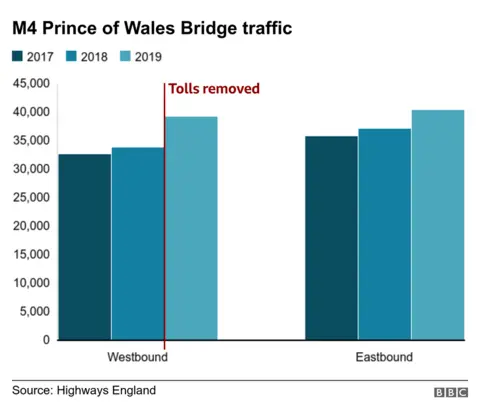M4 Prince of Wales Bridge journeys up 16% since toll removal
 Getty Images
Getty ImagesJourneys on the westbound carriageway on the Prince of Wales Bridge have increased by 16% in the year since the tolls were removed.
An average of more than 39,000 journeys are being made each day, up from less than 34,000 per day in 2018 when the £5.60 charge was still in place.
Highways England said traffic rose by about 32% on the M48 Bridge, but exact figures were not available.
The AA said the figures showed the toll removal had "gone to plan".
Concerns had been raised about increases of traffic after a UK government study said there could be six million more crossings of the two bridges by 2022, leading to more congestion at the Brynglas tunnels near Newport.

Tolls on the M4 Prince of Wales Bridge had been in place since the crossing was officially opened in 1996 and charges were also in place for the first Severn Crossing on the M48.
The charges rose as high as £6.70 for cars as recently as January 2018, but only applied on the westbound carriages of both bridges and were scrapped on 17 December 2018.
Work to remove the previous toll booths after the charges were scrapped continued into the spring, with temporary 50mph (80km/h) limits in place.

Journeys eastbound on the Prince of Wales Bridge increased by 8.9%, with an average of 40,364 crossings per day in 2019 compared to 37,056 in 2018.
In the past two years the eastbound carriageway had seen more than a daily average of 3,000 more journeys than the westbound carriageway, where the tolls applied.
But after the removals of the tolls, the difference has fallen to about 1,000 journeys more eastbound per day since the tolls were removed, with an average of 40,364 trips from Wales to England in 2019.
It means the bridge has been crossed about 24.2 million times in both directions between between January and October 2019, compared to 21.6 million times over the same 10 month period in 2018.
Similar statistics were not available on the M48 Severn Crossing due to technical issues with traffic counters in 2018.
But Highways England said there were typically 25,000 daily crossings on the bridge, compared to about 19,000 in recent years.
 Athena Pictures
Athena PicturesLuke Bosdet, from the AA, said: "The whole idea of lifting the tolls was to help stimulate the economy in Wales and there was an expectation that there would be an increase in traffic, so more traffic is a representation of a more vibrant economy that comes from taking away the tolls.
"The removing of the tolls on the Severn Crossing means it is being allowed to do its job, which is allowing traffic to move from England to Wales in its most efficient way.
"It's gone to plan. The whole idea of removing the tolls was to help the economy of Wales prosper."
